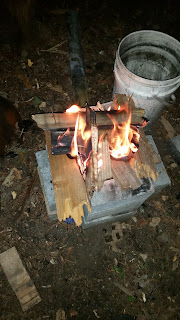Starting with this beast of a thing on the right:
And a bunch of fittings:
And some Pipe:
I managed to make an oil burner. I put an outlet in the bottom of the tank, blocked off one of the ports and put a T-piece on one of the other ports so I could let air into the tank.
I put the air in through a regulator I got from the hardware store. I'm not sure if it's because it was a cheap one, or it's designed to operate at higher pressure, or the setup was just wrong but I found that by clamping down on the plastic air hose going to the nozzle I could get the burner to run reliably. I had put a needle valve in the fuel flow so I had control of air and fuel. But I think the control of air was still too coarse. Before next weekend I will get another needle valve for the air and use that to control it, rather than a set of multi-grips:
While setting this up I did manage to tidy things up with a bit of cotton twine and parceled the fuel and air hoses together a bit to help control the tangle before reaching the mixer.
Hopefully this weekend I will get some more fittings and then will be able to get a video of this beast of a thing running. I used the blowtorch we saw here to light up the burner, but I had to keep it on hand as it was very prone to flameout which I think was because there was too much air coming through because the fuel is too viscous at the cooler winter temperatures.
Now that it is starting to cool down I have got some Metho for lighting up this burner. Unfortunately I haven't quite got the amount that I need right so starting it gets a little exciting. If anyone is interested I will do a video of me setting it on fire. Erm, lighting it...
Anyway that's all for tonight
Cheers,
Rex












































